英国文学课件 Crossing the Bar
- 格式:ppt
- 大小:628.00 KB
- 文档页数:22
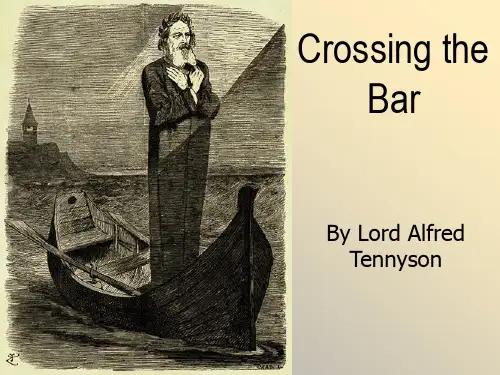
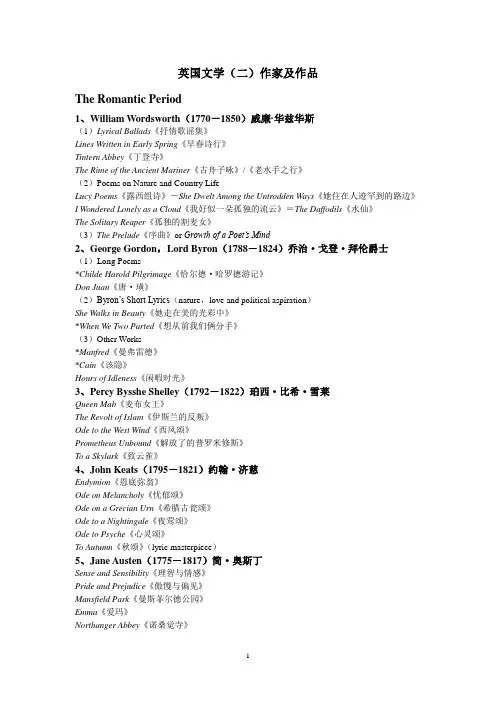
英国文学(二)作家及作品The Romantic Period1、William Wordsworth(1770-1850)威廉·华兹华斯(1)Lyrical Ballads《抒情歌谣集》Lines Written in Early Spring《早春诗行》Tintern Abbey《丁登寺》The Rime of the Ancient Mariner《古舟子咏》/《老水手之行》(2)Poems on Nature and Country LifeLucy Poems《露西组诗》-She Dwelt Among the Untrodden Ways《她住在人迹罕到的路边》I Wondered Lonely as a Cloud《我好似一朵孤独的流云》=The Daffodils《水仙》The Solitary Reaper《孤独的割麦女》(3)The Prelude《序曲》or Growth of a Poet’s Mind2、George Gordon,Lord Byron(1788-1824)乔治·戈登·拜伦爵士(1)Long Poems*Childe Harold Pilgrimage《恰尔德·哈罗德游记》Don Juan《唐·璜》(2)Byron’s Short Lyrics(nature,love and political aspiration)She Walks in Beauty《她走在美的光彩中》*When We Two Parted《想从前我们俩分手》(3)Other Works*Manfred《曼弗雷德》*Cain《该隐》Hours of Idleness《闲暇时光》3、Percy Bysshe Shelley(1792-1822)珀西·比希·雪莱Queen Mab《麦布女王》The Revolt of Islam《伊斯兰的反叛》Ode to the West Wind《西风颂》Prometheus Unbound《解放了的普罗米修斯》To a Skylark《致云雀》4、John Keats(1795-1821)约翰·济慈Endymion《恩底弥翁》Ode on Melancholy《忧郁颂》Ode on a Grecian Urn《希腊古瓮颂》Ode to a Nightingale《夜莺颂》Ode to Psyche《心灵颂》To Autumn《秋颂》(lyric masterpiece)5、Jane Austen(1775-1817)简·奥斯丁Sense and Sensibility《理智与情感》Pride and Prejudice《傲慢与偏见》Mansfield Park《曼斯菲尔德公园》Emma《爱玛》Northanger Abbey《诺桑觉寺》The Victorian Age6、Robert Browning(1812-1889)罗伯特·布朗宁The Ring and the Book《指环与书》My Last Duchess《我已故的公爵夫人》Home-Thoughts,from Abroad《海外乡思》7、Charles Dickens(1812-1870)查尔斯·狄更斯Pickwick Papers《匹克威克外传》Oliver Twist《奥立弗·特威斯特》The Old Curiosity Shop《老古玩店》Dombey and Son《董贝父子》David Copperfield《大卫·科波菲尔》Bleak House《荒凉山庄》Hard Times《艰难时世》A Tale of Two Cities《双城记》Great Expectations《远大前程》8、(1)Charlotte Bronte(1816-1855)夏洛蒂·勃朗特Jane Eyre《简·爱》Shirley《雪丽》The Professor《教授》(2)Emily Bronte(1818-1848)艾米丽·勃朗特Wuthering Heights《呼啸山庄》(3)Anne Bronte(1820-1849)安妮·勃朗特The Tenant of Wildfell Hall《威尔德·霍的佃户》9、Alfred,Lord Tennyson(1809-1892)阿尔弗雷德·丁尼生勋爵*In Memoriam《悼念》*Idylls of the King《国王田园诗》Break,Break,Break《碎了,碎了,碎了》Crossing the Bar《过沙洲》Twentieth Century Literature10、Thomas Hardy(1840-1928)托马斯·哈代Wessex Novels韦塞克斯小说Far from the Madding Crowd《远离尘嚣》The Return of the Native《回乡》The Mayor of Casterbridge《卡斯特桥市长》Tess of the D’Urbervilles《德伯家的苔丝》Jude the Obscure《无名的裘德》11、Oscar Wilde(1854-1900)奥斯卡·王尔德The Portrait of Dorian Gray《多里安·格雷的画像》Lady Windermere’s Fan《温德梅尔夫人的扇子》A Woman of No Importance《无足轻重的女人》The Importance of Being Earnest《认真的重要》Salome《莎乐美》12、George Bernard Shaw(1856-1950)乔治·萧伯纳Widowers’ Houses《鳏夫的房产》Mrs. Warren’s Profession《华伦夫人的职业》Pygmalion《卖花女》Saint Joan《圣女贞德》13、James Joyce(1882-1941)詹姆斯·乔伊斯Dubliners《都柏林人》A Portrait of the Artist as a Young Man《一个青年艺术家的画像》Ulysses《尤利西斯》Finnegans Wake《芬尼根守夜人》14、Virginia Woolf(1882-1941)(弗吉尼亚·沃尔夫)Mrs. Dalloway《黛洛维夫人》To the Lighthouse《到灯塔去》A Room of One’s Own《一间自己的房间》15、D. H. Lawrence(David Herbert Lawrence)(1885-1930)D. H. 劳伦斯Lady Chatterla y’s Lover《查泰莱夫人的情人》Sons and Lovers《儿子与情人》Women in Love《恋爱中的女人》The Rainbow《虹》。
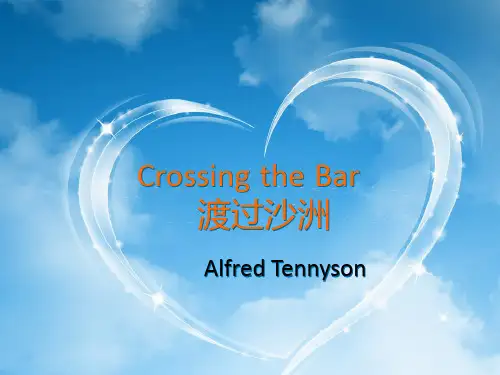
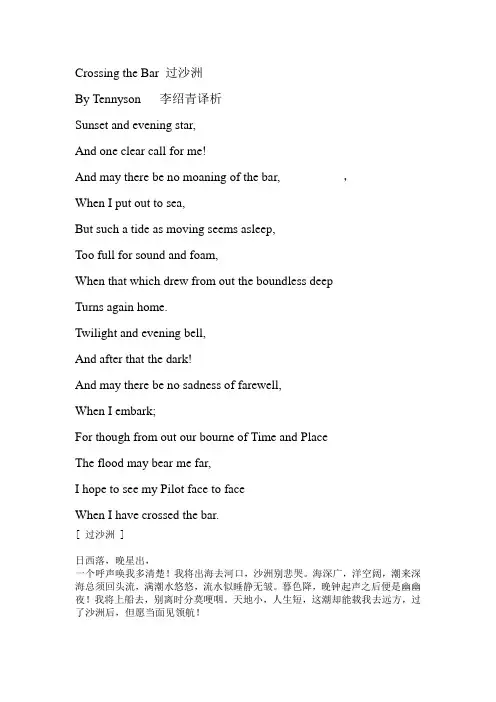
Crossing the Bar 过沙洲By Tennyson 李绍青译析Sunset and evening star,And one clear call for me!And may there be no moaning of the bar, ,When I put out to sea,But such a tide as moving seems asleep,Too full for sound and foam,When that which drew from out the boundless deepTurns again home.Twilight and evening bell,And after that the dark!And may there be no sadness of farewell,When I embark;For though from out our bourne of Time and PlaceThe flood may bear me far,I hope to see my Pilot face to faceWhen I have crossed the bar.[ 过沙洲 ]日西落,晚星出,一个呼声唤我多清楚!我将出海去河口,沙洲别悲哭。
海深广,洋空阔,潮来深海总须回头流,满潮水悠悠,流水似睡静无皱。
暮色降,晚钟起声之后便是幽幽夜!我将上船去,别离时分莫哽咽。
天地小,人生短,这潮却能载我去远方,过了沙洲后,但愿当面见领航!萧伯纳(George Bernard Shaw,1856—1950)爱尔兰剧作家,1925年「因为作品具有理想主义和人道主义」而获诺贝尔文学奖,是英国现代杰出的现实主义戏剧作家,是世界著名的擅长幽默与讽刺的语言大师。
萧伯纳的一生,是和社会主义运动发生密切关系的一生,他认真研读过《资本论》,公开声言他“是一个普通的无产者”,“一个社会主义者”。
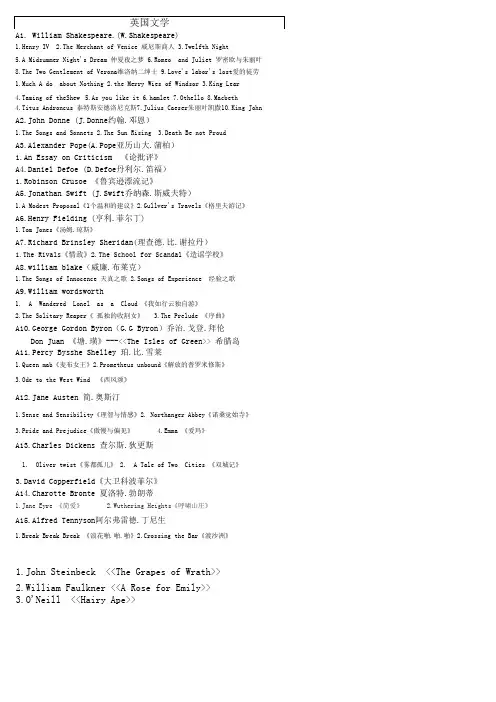
A1. William Shakespeare.(W.Shakespeare)1.Henry IV2.The Merchant of Venice 威尼斯商人3.Twelfth Night5.A Midsummer Night's Dream 仲夏夜之梦6.Romeo and Juliet 罗密欧与朱丽叶8.The Two Gentlement of Verona维洛纳二绅士 9.Love's labor's lost爱的徒劳1.Much A do about Nothing2.the Merry Wies of Windsor3.King Lear4.Taming of theShew5.As you like it6.hamlet7.Othello8.Macbeth4.Titus Androncus 泰特斯安德洛尼克斯7.Julius Caeser朱丽叶凯撒10.King JohnA2.John Donne (J.Donne约翰.邓恩)1.The Songs and Sonnets2.The Sun Rising3.Death Be not ProudA3.Alexander Pope(A.Pope亚历山大.蒲柏)1.An Essay on Criticism 《论批评》A4.Daniel Defoe (D.Defoe丹利尔.笛福)1.Robinson Crusoe 《鲁宾逊漂流记》A5.Jonathan Swift (J.Swift乔纳森.斯威夫特)1.A Modest Proposal《1个温和的建议》2.Gullver's Travels《格里夫游记》A6.Henry Fielding (亨利.菲尔丁)1.Tom Jones《汤姆.琼斯》A7.Richard Brinsley Sheridan(理查德.比.谢拉丹)1.The Rivals《情敌》2.The School for Scandal《造谣学校》A8.william blake(威廉.布莱克)1.The Songs of Innocence 天真之歌2.Songs of Experience 经验之歌A9.William wordsworth1. A Wandered Lonel as a Cloud 《我如行云独自游》2.The Solitary Reaper《 孤独的收割女》3.The Prelude 《序曲》A10.George Gordon Byron(G.G Byron)乔治.戈登.拜伦Don Juan 《塘.璜》---<<The Isles of Green>> 希腊岛A11.Percy Bysshe Shelley 珀.比.雪莱1.Queen mab《麦布女王》2.Prometheus unbound《解放的普罗米修斯》3.Ode to the West Wind 《西风颂》A12.Jane Austen 简.奥斯汀1.Sense and Sensibility《理智与情感》2. Northanger Abbey《诺桑觉始寺》3.Pride and Prejudice《傲慢与偏见》4.Emma 《爱玛》A13.Charles Dickens 查尔斯.狄更斯1. Oliver twist《雾都孤儿》2. A Tale of Two Cities 《双城记》3.David Copperfield《大卫科波菲尔》A14.Charotte Bronte 夏洛特.勃朗蒂1.Jane Eyre 《简爱》2.Wuthering Heights《呼啸山庄》A15.Alfred Tennyson阿尔弗雷德.丁尼生1.Break Break Break 《浪花啪.啪.啪》2.Crossing the Bar《渡沙洲》1.John Steinbeck <<The Grapes of Wrath>>2.William Faulkner <<A Rose for Emily>>3.O'Neill <<Hairy Ape>>1.Washington Irving 华盛顿•欧文1.Rip Van Winkle 《瑞普•凡•温克尔》2.The Legend of Sleepy Hollow睡谷的传说2.Ralph Waldo Emerson拉尔夫.华尔多.爱默生Nature 《论自然》3.Nathaniel Hawthorne纳撒尼尔.霍桑Young Goodman Brown 《小伙子布朗》4.Walt Whitman 华尔特.惠特曼1.Leaves of Grass 《草叶集》2.Song of Myself《自我之歌》5.Mark Twain 马克吐温1.The Adventures of Tom Sawyer《汤姆.索亚历险记》2.Adventures of Huckleberry Finn 《哈克贝利劳历险记》6.Theodore Dreiser 西奥多.德莱塞Sister Carrie 《嘉莉妹妹》7.Ezra Pound 埃兹拉.庞德In a Station of the Metro 《在地铁车站》8.Robert Lee Frost罗伯特.李.弗洛斯特1.After Apple-Picking2.The Road Not Taken《未选择的路》3.Stopping by Woods on a Snowy Eevening《雪夜村边停》9.F.Scott FitzgeraldThe Great Gatsby 《了不起的盖茨比》10.Ernest Hemingway 欧内斯特.海明威1.The Sun Also Rises 《太阳照样升起 》2.The Old Man and the Sea 《老人与海》3.A Farewell to ArmsA16.Robert Browning 布朗宁1.My Last Duchess 《我前一位公爵夫人》A17.Thomas Hardy1.The Return of the native 《还乡2.The Woodlanders《林地居民》3.The Trumpet Majoy《号兵长》4.The Mayor of Casterbridge《卡斯特桥市长》5.Tess of the d‘Urbervilles《德伯家的苔丝》6.Jude the Obscure《无名的裘德》B1.George Bernard Shaw 乔治.萧伯纳1.Widower‘s House 《渔夫房产》2.Mrs.Warren‘s Profession《沃伦夫的职业》B2.William Butler Yeats(W.B.Yeats)威廉.巴特勒.叶芝1.The Lake Isle of Innisfree《茵尼斯弗莉湖岛》2.Downby the Salley Gardens《来到柳园》B3.T.S.Eliot 艾略特1.The Love Song of J.Alfred Prufrock 布鲁富劳克的情歌2.The Waste Land荒原B4.Jame Joyce 詹姆斯.乔伊斯1.Dubliners 《都柏林 》2. Ulysses 《尤利西斯》2.A Portrait of the Artist as a Young Man 《艺术家年轻时代的肖像》。
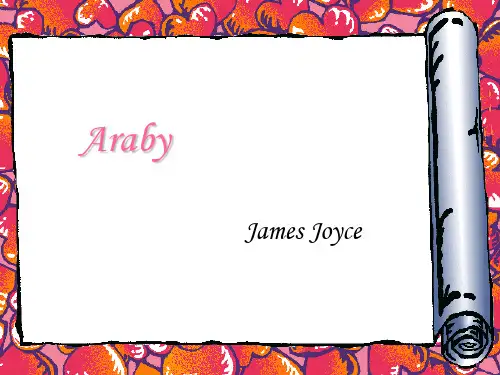
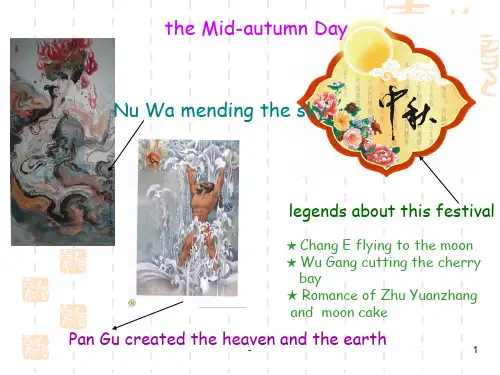
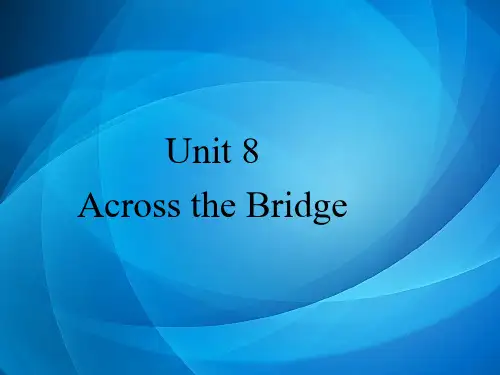


《英国文学史及选读》复习题Part One: Brief Questions1.What‟s the symbolic meaning of the “Vanity Fair” in Bunyan‟s “The Pilgrim‟sProgress”?2.What can we see from the Soliloquy of Hamlet?This is an internal philosophical debate on the advantages and disadvantages of existence, and whether it is one's right to end his or her own life. It presents a most logical and powerful examination of the theme of the moral legitimacy of suicide in an unbearably painful world.3.What‟s the main idea of “Of Studies” by Bacon?It analyzes what studies chiefly serve for, the different ways adopted by different people to pursue studies, and how studies exert influence over human character.4.What‟re the four stories of “Gulliver‟s Travels” by Swift?The first part tells about Gulliver‟s experience in Lilliput;in the second part,Gulliver is left alone in Brobdingnag;the third part deals mainly with his accidental visit to the Flying Island and the last part is a most interesting account of his discoveries in the Houyhnhnm land.5.What‟s the writing feature of Beowulf?1 ) It is not a Christian but a pagan poem, despite the Christian flavor given to it by themonastery scribe. It is the product of all advanced pagan civilization. The whole poem presents us an all-round picture of the tribal society. The social conditions and customs can be .seen in it. So the poem has a great social significance.2) The use of the strong stress and the predominance of consonants are very notable inthis poem. Each line is divided into two halves, and each half has two heavy stresses.3) The use of the alliteration is another notable feature. Three stresses of the whole lineare made even more emphatic by the use of alliteration.4) A lot of metaphors and understatements are used in the poem. For example, the sea iscalled "the whale-road" or "the swan road"; the soldiers are called "shield-man"; the chieftains are called the "treasure keepers"; human-body is referred to as "the bone-house"; God is called "wonder-wielder"; monster is referred to as "soul-destroyer''.6.What‟s the contribution made by Geoffrey Chaucer?He introduces from France the rhymed stanzas of various types, esp. the rhymed couplet of iambic pentameter (…heroic couplet‟) to English poetry. He is the first great poet who wrote in the current English language, making the dialect of London the foundation for modern English speech.7.What‟s the historical significance of the Glorious Revolution?The supremacy of ParliamentThe beginning of modern EnglandThe final triumph of the principle of political liberty8.Explain the literary trends in the 17th century.One of confusion, due to the breaking up of old ideas.Medieval standards of chivalry, impossible loves and romances, the ideal of a national church perishedDisapproving of the sonnets and the love poetry, and theatres was closed then.Bible became the only book to read.It tended to suppress literary art.Part Two: Detailed Appreciation9.Read the poem (“Sonnet 18” by Shakespeare) and answer the following questions.a)What is the theme of the poem?Theme: a profound meditation on the destructive power of time and the eternal beauty brought forth by poetry to the one he loves.b)Explain the rhyme and tone in the poem by drawing the first two lines. Rhetorical questioning: the 1st line, used to create a tone of respect, and to engage the audience.c)Why is the speaker‟s loved one more lovely than a summer‟s day?If I compared you to a summer day, / I'd have to say you are more beautiful and serene: / By comparison, summer is rough on budding life, / And doesn't last long either:Extravagant praise compares a summer day as less lovely and constant as the beloved.10.Read the poem (“Sonnet 29” by Shakespeare) and answer the following questions.a)In the first two thirds of the sonnet, the speaker is complaining about themisfortunes in his life. What suddenly lifts him out of his bad mood?b)In the last line, the speaker scorns to change his state with kings. What doesthe word “state” mean?11.Read the poem (“Song: Go and Catch the Falling Star” by Donne) and answer thefollowing questions.a)What is the speaker‟s tone? What‟s his opinion about the constancy ofwomen?This poem chief concerns the lack of constancy in women.b)How much impossibility does Donne list in the poem? What are they? What‟sthe additional impossibilities does he have in mind throughout this stanza?There is seven impossibility list in the poem and they are catch a falling star, Get with child a mandrake roote, all past yeares, cleft the Divels foot, hear Mermaides singing, keep off envies stinging and advance an honest minde.The additional impossibilities in his mind is Lives a woman true.12.Read the poem (“A Valediction: Forbidding Mourning” by Donne) and answer thefollowing questions.a)Why does Donne‟s “Valediction” (a poem of farewell) forbid mourning?b)Comment on the relation of the various images to each other. Is there adevelopment of some kind?13.Read the poem (“The Flea” by Donne) and answer the following questions.a)Who‟re the speaker and the listener? What‟s the situation in the poem?The speaker is a man and the listener is a lady.b)How‟s the speaker‟s reasoning to persuade the listener? And point out theconceits used in the poem.14.Read the poem (“Elegy Written in a Country Churchyard” by Gray) and answerthe following questions.a)How does Gray begin the essay?b)Where does Gray begin to make a shift from visual to acoustic perception?Why?c)From which stanza, does Gray begin to describe the country churchyard?d)How many sounds does Gray employ in stanza 5? Wha t‟re they, and why doeshe make a list of these sounds?e)What‟s the main idea of stanza 6?f)What can we see about the occupation of the dead person from stanza 7?Please make a list of the words which can certify your guess.g)What do stanzas 8 and 9 tell us?15.Read the poem (“The Tiger” by Blake) and answer the following questions.a)Analyze the form and rhythm of the poem, and what‟s the central question inthis poem?b)What do the lamb and the tiger represent respectively?The problem with that, though, is that the speaker of “The Lamb” sees the creator as a lamb. The speaker of “The Tyger” sees only tygers, and therefore the Creator must be like a tyger.T he problem is in the basic selection process. And what causes him to make that selection is what he believes. If he believes that the world is shaped by mercy, pity, peace and love, then that‟s what he‟s going to see, a lamb as the creator. And vice versa with the tyger.16.Read the poem (“London” by Blake) and answer the following questions.a)Analyze the form and rhythm of the poem.The poem has four quatrains, with alternate lines rhyming. Repetition is the most striking formal feature of the poem, and it serves to emphasize the prevalence of the horrors the speaker describes.b)What kind of picture about London do you have in your mind after reading thepoem (London)? Describe in your own words with supportive details from thepoem.17.Read the poem (“Lines” by Wordsworth), from the beauteous forms in heart, thepoet could see into the life of things. How did it come? Analyze it by drawing a flow chart.18.Read the poem (“Break, Break, Break” by Tennyson) and answer the foll owingquestions.a)What feelings of loss arise in the speaker as he looks out at the sea breakingendlessly against the shore?b)The meter of lines 1 and 13 obviously differ from that of the whole poem. Howdo they differ, and how do they control the tone of the poem? What is the effectof the repetition?c)In the second stanza, what does the poet describe? What do you think is hisintention for giving such a setting? And how does this setting intensify the speaker‟s mood?19.Read the poem (“Crossing the Bar” by Tennyson) and answer the followingquestions.a)What overall mood and atmosphere does Tennyson create in this poem?This poem was written in the later years of Tennyson‟s life. We can feel hisfearlessness towards death, his faith in God and an afterlife.Bar: a bank of sand or stones under the water as in a river, parallel to the shore, at the entrance to a harbor.“Crossing the Bar” means leaving this world and entering the next world.b)Instead of saying death directly, Tennyson uses a metaphor. What is themetaphor? How effective is it used?Metaphor is a figure of speech. It refers to a comparison between unlikethings without the use of "like" or "as". This comparison is done between two things that are basically different but have something in common in some significant way. It is used in reference to something that does not literallysuggest a similarity. Metaphor is different from a simile or analogy because metaphor asserts that one thing is another thing and not just that they are like one another.Sunset,evening star,twilight,evening bell:all images of the end of life.c)What is Tennyson‟s attitude towards death?This poem was written in the later years of Tennyson‟s life. We can feel hisfearlessness towards death, his faith in God and an afterlife.Part Three: Reading Comprehension20.“And thus the native hue of resolution / Is sicklied o'er with the pale cast ofthought.”a)Identify the title and the author.The author is William Shakespeare and the title is Hamlet.b)What idea do the lines express?1.lose the honor due to action2.Our conscience makes us cowards, our natural colour is drained by theprospect of it. Things of gravity and importance lose their momentum.The “native hue of resolution” is the resolve to kill one‟s self;it‟s what‟s “sicklied o‟er with the pale cast of thought”Hamlet thus concludes that the dread of the afterlife leads to excessive moral sensitivity that makes action impossible.21.“Whether I went over by the ladder, as first contrived, or went in at the hole in therock, which I called a door, I cannot remember; no, nor could I remember the next morning, for never frighted hare fled to cover, or fox to earth, with more terror of mind than I to this retreat.”a)Identify the title and the author of the selected part.The title is Robinson Crusoe and the author is Daniel Defoe.b)Why was I so frighted, according to the story?22.“If he be not apt to beat over matters, let him study the lawyer‟s cases. So everydefect of the mind may have a special receipt.”a)Identify the author and the essay from which the quoted sentences are taken.The auther is Francis Bacon and the essay is Of Studies.b)What is the essay mainly about?It analyzes what studies chiefly serve for, the different ways adopted by different people to pursue studies, and how studies exert influence over human character.23.“Five hundred carpenters and engineers were immediately set at work to pre pare thegreatest engine they had. It was a frame of wood raised three inches from the ground, about seven foot long and four wide, moving upon twenty-two wheels.”a)Identify the title and the author.The title is Gulliver's Travels and the author is Jonathan Swift.b)Why did they make such a great engine?。

英语诗歌欣赏1.一首诗(a poem)往往包含有若干诗节(stanze),每节又分为若干行(line 或verse),每个诗行由若干音步(foot)组成,音步则是由一定数目的重读音节(arsis或ictus)和非重读音节(thesis)按照一定规律排列而成。
音步的排列方式构成英诗的格律(meter 或 measure)。
2.依照每一音步中重读音节(扬)和非重读音节(抑)的排列方式,可以把音步分成不同种类,即格律。
常见的英语诗歌格律有四种。
a)抑扬格(Iambus; the Iambic Foot):一个音步由一个非重读音节加上一个重读音节构成。
b)扬抑格(Trochee; the Trochaic Foot):一个音步由一个重读音节加上一个非重读音节构成。
c)扬抑抑格(Dactyl):一个音步由一个重读音节加上两个非重读音节构成。
d)抑抑扬格(Anapaest; the Anapaestic Foot):一个音步由两个非重读音节加上一个重读音节构成。
不常见的几种格律:e)抑扬抑格(Amphibrach; the Amphibrachy Foot):一个音步由三个音节组成,其中第一、三个音节为非重读音节,第二个音节为重读音节。
f)扬扬格(Spondee):一个音步由两个重读音节构成。
g)抑抑格(Pyrrhic):一个音步由两个非重读音节构成。
3.音步也有完整和不完整之分。
诗行中每个音步的格律都相同,则为完整音步(actalectic foot);如果诗行最末一个音步缺少一个音节,则为不完整音步(cactalectic)。
4.诗的各行音步数目不定,诗行按音步数量分为以下几种:一音步(monometer)、二音步(dimeter)、三音步(trimeter)、四音步(tetrameter)、五音步(pentameter)、六音步(hexameter)、七音步(heptameter)、八音步(octameter)超过八音步的诗行在英语诗歌中较为少见。
III. Alfred Tennyson 1.⼀般识记 His Life & Literary Career Alfred Tennyson (1809-1892) is certainly the most representative Victorian poet. His poetry voices the doubt & the faith, the grief & the joy of the English people in an age of fast social changes. He was born at Somersby, Linconshire, the fourth son of a rather learned clergyman. In 1827, he & his elder brother published Poems by Two Brothers. In this juvenile work the influence of Byron & an attraction to oriental themes were shown. He was educated at the Trinity College, Cambridge & published his first signed work Poems, Chiefly Lyrical (1830)there. In 1832, one year after he left Cambridge, he published Poems, which contained a variety of poems, beautiful in melody & rich in imagery. In 1842, his next issue of Poems came out, collected in the book are the dramatic monologue "Ulysses", the epic narrative " Morte d''Arthur," the exquisite idylls "Dora" & " The Gardener''s Daughter," etc. In 1847,The Princess was published. Written in blank verse, it deals with the theme of women''s rights & position. In 1850,Tennyson was appointed the Poet Laureate & he published his greatest work In Memoriam. The rest years of Tennyson''s life was comfortable & peaceful, but he never stopped writing. In 1855, Tennyson published a monodrama Maud, a collection of short lyrics. Among the other works of his later period, "Rizpah," "Enoch Arden," " Merlin & the Gleam" & " Crossing the Bar" are worthy of note. 2.识记 His major poetic works & their theme 1) In Memoriam Presumably it is an elegy on the death of Hallam, yet less than half of its l00 pieces are directly connected with him. The poet here does not merely dwell on the personal bereavement. As a poetic diary, the poem is also an elaborate & powerful expression of the poet''s philosophical & religious thoughts - his doubts about the meaning of life, the existence of the soul & the afterlife, & his faith in the power of love & the soul''s instinct & immortality. Such doubts & beliefs were shared by most people in an age when the old Christian belief was challenged by new scientific discoveries, though to most readers today, the real attraction of the poem lies more in its profound feeling & artistic beauty than in the philosophical & religious reflections. The familiar trance-like experience, mellifluous rhythm & pictorial descriptions make it one of the best elegies in English literature. 2) Idylls of the Kin g (1842-1885) It is his most ambitious work which took him over 30 years to complete. It is made up of 12 books of narrative poems,based on the Celtic legends of King Arthur & his Knights of the Round Table. But it is not a mere reproduction of the old legend, though. It is a modern interpretation of the classic myth. For one thing, the moral standards & sentiments reflected in the poem belong to the Victorians rather than to the medieval royal people. For another, the story of the rise & fall of King Arthur is, in fact, meant to represent a cyclic history of western civilization, which , in Tennyson''s mind , is going on a spiritual decline & will end in destruction. 3.领会Artistic Features of His Poetry Tennyson is a real artist. He has the natural power of linking visual pictures with musical expressions, & these two with the feelings. He has perfect control of the sound of English, & a sensitive ear, an excellent choice & taste of words. His poetry is rich in poetic images & melodious language, & noted for its lyrical beauty & metrical charm. His works are not only the products of the creative imagination of a poetic genius but also products of a long & rich English heritage. His wonderful works manifest all the qualities of England''s great poets. The dreaminess of Spenser, the majesty of Milton, the natural simplicity of Wordsworth, the fantasy of Blake & Coleridge, the melody of Keats & Shelley, & the narrative vigor of Scott & Byron, —— all these striking qualities are evident on successive pages of Tennyson''s poetry. 4. 应⽤ Selected Readings (1) Break This short lyric is written in memory of Tennyson''s best friend, Arthur Hallam, whose death has a lifelong influence on the poet. Here, the poet''s own feelings of sadness are contrasted with the carefree, innocent joys of the children & the unfeeling movement of the ship & the sea waves. The beauty of the lyric is to be found in the musical language & in the association of sound & images with feelings & emotions. The poem contains 4 quatrains, with combined iambic & anapaestic feet. Most lines have three feet & some four. The rhyme scheme is a b c b. (2) Crossing the Bar This poem was written in the later years of Tennyson''s life. Although not the last poem written by Tennyson in his longcreative career, this poem appears, at his request, as the final poem in all collections of his works. The scene is sketched with a few strokes: sunset & the evening star, the twilight and the evening bell, & then the dark. The ship is ready to go out of the harbor. It will cross the bar & reach the vast open sea for the long voyage that it is to make. The allegory of the poem is clear. Tennyson is in the evening of life, & the "clear call" of death will come soon. But when he has crossed the border between life & death to go on that voyage beyond the bound of Time & Place, he hopes then to see his "Pilot," God, face to face. From the moving imagery & the pleasant sound of the poem, we can feel his fearlessness towards death, his faith in God & an afterlife. (3) Ulysses In Greek mythology, Ulysses is the king of the Ithaca Island. He is the hero in many literary classics. In Homer''s Odessey (the Greek name for Ulysses), Ulysses eventually arrives home after the ten-year Trojan war & another ten-year''s adventures at sea. However, according to Dante, Ulysses never returns to his home place Ithaca, but urges his men to go on exploring westward. Tennyson combines these two versions. In this poem, Ulysses is now three years back in his homeland, reunited with his wife Penelope & his son Telemachus, & resumes his rule over the land. But he will not endure the peaceful commonplace everyday life. Old as he is, he persuades his old followers to go with him & to sail again to pursue a new world & new knowledge. Written in the form of dramatic monologue, the poem not only expresses,through the mouth of the heroic Ulysses, Tennyson''s own determination & courage to brave the struggle of life but also reflects the restlessness & aspiration of the age. IV. Robert Browning 1.⼀般识记His life &Literary Career Robert Browning (1812-1889) was born in a well-off family & received his education mainly from his private tutor, & from his father, who gave him the freedom to follow his own interest. In 1833, he published his first poetic work Pauline,which brought great embarrassment upon him. But in his second attempt Sordello (1840), he went too far in self-correction that the poem became so obscure as to be hardly readable. He even tried play writing but failed. All these frustrating experiences forced the poet to develop a literary form that suited him best & actually give full swing to this genius, i.e. the dramatic monologue. In 1846, Browning married Elizabeth Barrett, a famous poetess whose famous book of love poetry was Sonnets from the Portuguese. In 1869 Browing''s masterpiece, The Ring & the Book, came out. In 1889, Browning died & was buried in the Poet''s Corner, Westminster Abbey, beside Tennyson. 2.识记His major works Dramatic Lyrics (1842), Dramatic Romances & Lyrics (1845), Bells & Pomegranates (1846), Men & Women (1855), Dramatic Personae (1864), The Ring & the Book (1868-1869) & Dramatic Idylls (1880) 3.领会Characteristic of The Ring & the Book: Dramatic M onologue In this poem, Browning chooses a dramatic moment or a crisis, in which his characters are made to talk about their lives, & about their minds & hearts. In "listening" to those one-sided talks, readers can form their own opinions & judgments about the speaker''s personality & about what has really happened. 4.领会Robert Browning''s artistic characteristics (1) The name of Browning is often associated with the term "dramatic monologue." Although it is not his invention, it is in his hands that this poetic form reaches its maturity& perfection. (2) Browning''s poetry is not easy to read. His rhythms are often too fast, too rough & unmusical (3) The syntax is usually clipped & highly compressed. The similes & illustrations appear too profusely. The allusions & implications are sometimes odd & far-fetched. All this makes up his obscurity. On the whole, Browning''s style is very different from that of any other Victorian poets. He is like a weather-beaten pioneer, bravely & vigorously trying to beat a track through the jungle. His poetic style belongs to the 20th-century rather than to the Victorian age. 5. 应⽤ Selected Readings: 1) My Last Duchess。